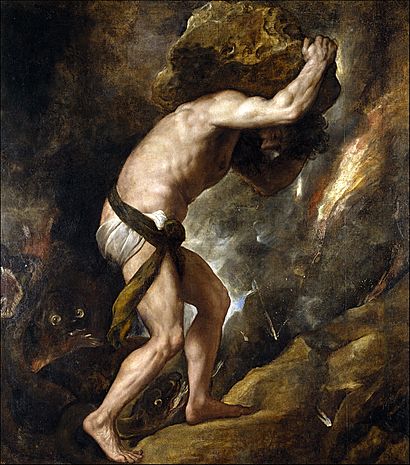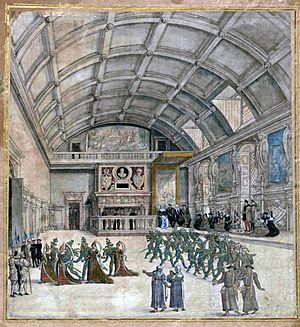Sisyphus (Titian) facts for kids
Quick facts for kids Sisyphus |
|
|---|---|
 |
|
| Artist | Titian |
| Year | 1548–1549 |
| Medium | Oil on canvas |
| Dimensions | 237 cm × 216 cm (93 in × 85 in) |
| Location | Museo del Prado, Madrid |
Sisyphus (Spanish: Sísifo) is an oil painting by the Venetian master Titian, made in 1548 or 1549. It is in the collection of the Museo del Prado in Madrid.
Subject
From Homer onwards Sisyphus was famed as the craftiest of men. In the underworld Sisyphus was compelled to roll a big stone up a steep hill; but before it reached the top of the hill the stone always rolled down, and Sisyphus had to begin all over again. The subject was a commonplace of ancient writers, and Titian's source was a passage in Ovid's Metamorphoses, which recounts the eternal sufferings of several personages in the underworld:
Thither, leaving her abode in heaven, Saturnian Juno endured to go; so much did she grant to her hate and wrath. When she made entrance there, and the threshold groaned beneath the weight of her sacred form, Cerberus reared up his threefold head and uttered his threefold baying. The goddess summoned the Furies, sisters born of Night, divinities deadly and implacable. Before hell's closed gates of adamant they sat, combing the while black snakes from their hair. When they recognized Juno approaching through the thick gloom, the goddesses arose. This place is called the Accursed Place. Here Tityos offered his vitals to be torn, lying stretched out over nine broad acres. Thy lips can catch no water, Tantalus, and the tree that overhangs ever eludes thee. Thou, Sisyphus, dost either push or chase the rock that must always be rolling down the hill again. There whirls Ixion on his wheel, both following himself and fleeing, all in one; and the Belides, for daring to work destruction on their cousin-husbands, with unremitting toil seek again and again the waters, only to lose them.
History
On his first visit to Augsburg Titian received a new commission from Charles V's sister, Queen Mary of Hungary. Titian had to execute two or three large pictures, which should represent Tantalus, Sisyphus and Tityus. Two of them were painted in the first half of 1549; for they already adorned the Great Hall of the Summer Palace of Binche, for which the Queen evidently had destined them, in the August of the same year when Philip was her guest in the Low Countries. However, the last picture of this series, the Tityus, was not executed till much later, in about 1553.
The Queen took the collection of pictures (some by Titian and some by other hands) with her to Spain; in the sixteenth century they hung in the Alcázar at Madrid, and gave to the room its name, Pieza de las Furias, which may be translated "the room of the Forces". In course of time the Tantalus was lost, and the Tityus and Sisyphus, still remaining in the Prado, were once supposed, on the strength of ancient testimony, to be copies by the hand of Sánchez Coello. Georg Gronau writes, "If so Coello must have worked with the highest skill in imitation of Titian's style. The two pictures really display all the bold design, the touch, and the colouring of Titian, and should be reckoned among his finest original creations." Charles Ricketts says they are very properly ascribed to Titian instead of being described as copies by the "cold, bad colourist", Sánchez Coello.
Provenance
- 1700—Royal Collection (Royal Alcázar, Madrid), no. 3;
- 1747–1818—New Royal Palace, Madrid, no. 32;
- 1819–present—Museo del Prado, Madrid, no. P000426.
Gallery
-
Titian: Sisyphus (1549)
See also
 In Spanish: Sísifo (Tiziano) para niños
In Spanish: Sísifo (Tiziano) para niños
- List of works by Titian
- The Myth of Sisyphus
Sources
- Falomir Faus, Miguel (2003). "Sisyphus". Museo Nacionel del Prado. Retrieved 21 August 2022.
Attribution:
 This article incorporates text from a work in the public domain: Gronau, Georg (1904). Titian. London: Duckworth and Co; New York: Charles Scribner's Sons. pp. 155–156, 194, 305.
This article incorporates text from a work in the public domain: Gronau, Georg (1904). Titian. London: Duckworth and Co; New York: Charles Scribner's Sons. pp. 155–156, 194, 305. This article incorporates text from a work in the public domain: Ricketts, Charles (1910). Titian. London: Methuen & Co. Ltd. pp. 119, 187, plate cxii.
This article incorporates text from a work in the public domain: Ricketts, Charles (1910). Titian. London: Methuen & Co. Ltd. pp. 119, 187, plate cxii.




